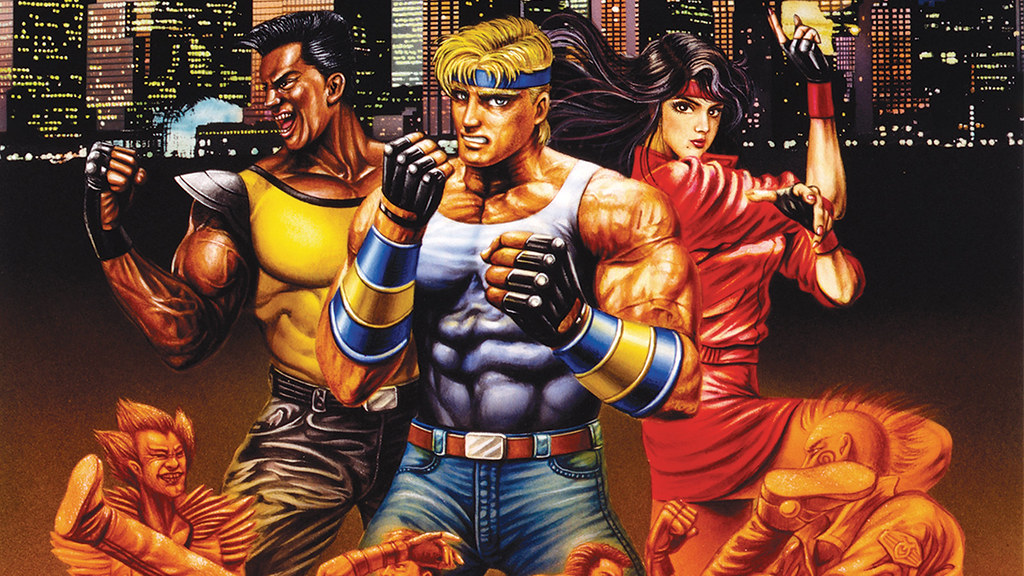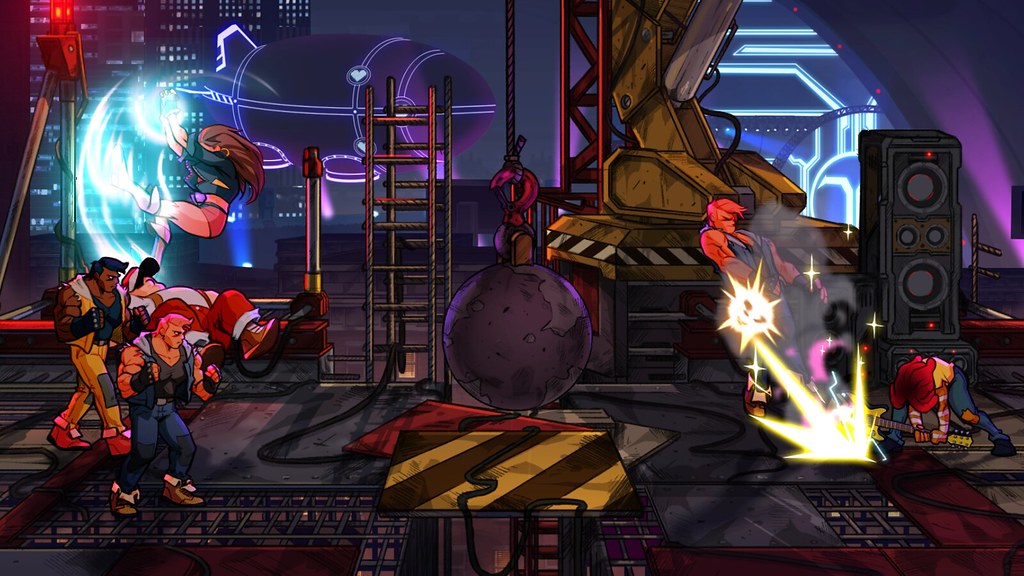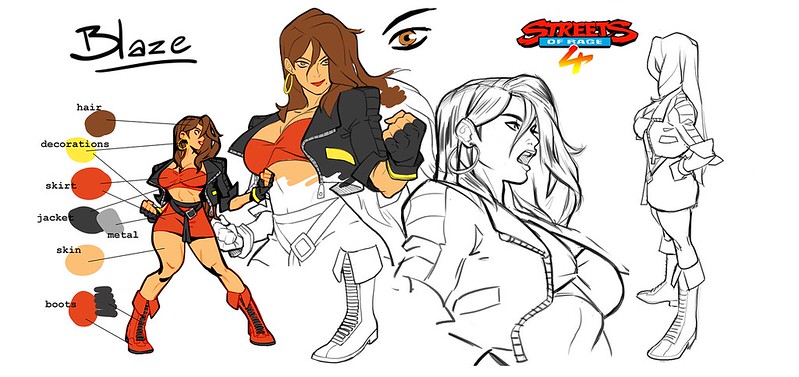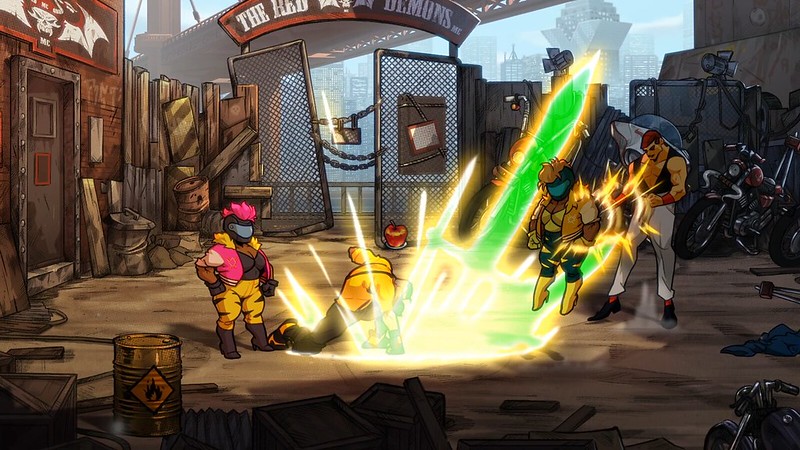Here is a sentence I did not think I’d be writing in 2020: a new Streets of Rage game launches today.
Why the surprise? It’s not only because it has been 26 years since the last one, but that the original side-scrolling beat ’em up trilogy was rightly celebrated at the time and has been venerated by genre aficionados ever since. How could any modern-day studio hope to resurrect the series, recapture that magic?
As it turns out, one couldn’t. But three might. Guard Crush Games (who created a love letter to the genre in the form of 2015’s Streets of Fury and handled programming duties on Streets of Rage 4), LizardCube (responsible for the gorgeous visual overhaul on 2017’s Wonder Boy: A Dragon’s Trap remake and who looked after art direction here) and Dotemu (retro-loving, Paris-based studio who took care of SoR4’s game design and general production) joined forces and embarked on a three year journey to re-imagine Streets of Rage for a PS4 audience.
To find out the story behind what may be this generation’s most surprising retro revival, I reached out to a number of people working on the title.
Kindly setting aside time in the last few days before their game’s launch – and giving us a taste of the collaborative nature of the project – were Dotemu’s Executive Producer Cyrille Imbert and Lead Game Designer Jordi Asensio, Lizardcube’s Art Director Ben Fiquet and Guard Crush Games Technical Director Cyrille Lagarigue, as well as composer Olivier Deriviere.
Let’s Go Straight to their answers.
Maintaining an iconic legacy

Adam Hunter, Axel Stone and Blaze Fielding as they appeared in the key art for 1991’s Mega Drive classic Bare Knuckle. The game would be rebranded Streets of Rage for its western release.
This series is well-loved for so many reasons. Its gameplay, music, and design are all iconic. There must have been a lot of attention on every development decision made. What aspect did you feel the most pressure to deliver on?
Asensio: Every aspect, really. The original games are so well crafted that you cannot leave any aspect unpolished. For my part I tried to give people instant fun while creating a deep system that will make people interested in mastering the game and come back again and again.
Lagarigue: The overall dynamic of the fights, so that they feel fluid and strategic but still snappy.
Imbert: A bit of everything. But the game feel, the gathering of different aspects like the design, the animation, and the reactivity was definitely something we had to nail. The music was also something that absolutely needed to succeed.
Obviously Streets of Rage has a very unique look and feel. How much did player – or even developer – feedback impact the final level and character designs?
Asensio: As a matter of fact we talked a lot with hardcore fans and they gave us tremendous feedback and ideas. Every event we could show a demo at (like PAX) was a gold mine. We changed, added, and balanced considerably thanks to this feedback. Smiles and praise were also key to keeping us focused on our work.
Fiquet: Before starting production, I spent a lot of time researching game design documents, interviews with the developers, in-depth video analysis, fan-made games, even fan art. This helped me get a sense of the overall feelings surrounding the license.
Reimagining Streets of Rage for 2020

The key art for Streets of Rage 4, featuring (clockwise from top left) Blaze Fielding, Axel Stone, Floyd Iraia, Adam Hunter, Cherry Hunter
Has Streets of Rage 4 evolved much from its original concept, or did you have a pretty clear idea of what it would be from the start?
Asensio: From the start we wanted it to be a pretty straightforward beat ’em up with no fancy modern trends. Just a good old-fashioned beat ’em up. Then as the game was coming together, we found room for improvement: adding more fun, along with modern solutions to old frustrations, without ever losing track of the game’s roots.
Imbert: The idea was crystal clear for everyone: we just wanted to do a great beat ’em up game. Something pure, simple, and efficient. Something that would be in line with its predecessor, but modern in its approach.
Can you touch on the modern-day additions you’ve brought to the classic SoR gameplay formula, and explain why you added them?
Asensio: There are small things (but which make a big difference), like downsizing the depth of the player character’s hitbox when moving up or down, so you really dodge when you want to dodge. And bigger things – for example, in SoR2 when you were surrounded, doing a special move was smart, but it cost a small amount of health. So it was better than being hit, but it always felt a little off to lose health for a good decision. So in SoR3 they added a cool-down bar that allowed you to do your special move for free.
We tried something different. In SoR4, you lose a small amount of health that you can regain by hitting enemies – but if you are hit in the meantime, this small amount of health is gone for good. This opens the door for some aggressive play styles, gambling a lot of life in order to do huge combos. Some players will prefer to use specials more wisely though…
We also added powerful ‘Star’ moves, which replace the old ‘police call’. Police call is a ‘clear screen’ mechanic, and though it’s fun, we wanted to have something more befitting our gameplay loop. So now you have to think more to connect your Star move, as it hits only a certain portion of the screen, which is dependent on your character. It can save you from a lot of enemies (sort of like an emergency defense mechanism), but it can also extend the length of a combo. This helps you recover some invested health from special moves and focus your damage on a boss, for instance.

Many levels have environmental dangers. You can use the wrecking ball in this rooftop fight to knock out enemies (and score a Trophy)
Lagarigue: We wanted to give the players more freedom on how they can play. We changed the rules of the main game mode (Story mode) so that you restart at the beginning of each stage when you run out of lives. Also, if you are stuck you can choose to get gameplay assists (more lives, Star moves…) in exchange for a reduced score.
This way, everyone can finish the campaign, but you are still tempted to choose a higher difficulty level because you know that you will be able to get help if you are stuck. Then you can train and improve your score on each level or try the old-school-style Arcade mode. So the goal was really to keep the challenge while making the game more accessible.

“You can unlock retro characters by scoring points, and you get bonus points when you play at higher difficulty levels or when you try different characters. So overall you are incentivized to get better and play in a variety of ways.” – Cyrille Lagarigue
Creating new characters…
How much iteration did Cherry Hunter and Floyd Iraia go through in terms of design and combat style before you agreed on their final versions?
Asensio: Usually we do a kick-off meeting where we discuss each character’s overall style and gameplay. Then we go in to details move-by-move to determine the function of the move and maybe find a pose that will fit. Then it’s up to Ben [Fiquet, Lizardcube’s Art Director] to work his magic. Sometimes moves change because Ben finds something cool visually that may (or may not) fit the gameplay, but in the end the animation influences gameplay as much as gameplay influences animation – so we always find common ground.
For Cherry Hunter it took several iterations to balance her two sides, bare-hands move, and guitar moves. We pushed the sliders to the max so the bare-hands move feels really fast and swift, while the guitar moves feel really slow but powerful, with range and a big zone of impact.
Fiquet: Graphically speaking, both characters were driven by their function – but I was adamant on Cherry’s guitar despite some push-back from the team. I wanted something that would be truly unique in the series and cool looking. Ultimately though, I wanted characters that would fit right in with the Streets of Rage universe.
Asensio: Floyd was pretty straightforward, since he was the last character and we knew what we needed for the game to have a good, rounded character roster. The biggest challenge was to work around the unique concept of a “ranged grappler”. It took several iterations, even some last-minute ones, to balance him well, since his telescopic grapple can win against a lot of AI behaviour (yes, we ended up changing the AI a little bit for him).
… and reimagining the classic brawlers
In the same vein, were Blaze, Adam, and Axel easier to design because you could adapt the blueprint of their looks and combat styles from SoR 1 – 3?
Asensio: From the start we decided that they should have their iconic moves, but I changed their properties. So for instance, Axel’s neutral jump kick now just does one hit, but it’s more powerful and it sets enemies bouncing off the wall.
Fiquet: Axel wasn’t easy to design artistically. I knew giving him a beard and bulking him up would be quite a leap for many, but I felt the character needed to get rougher with time. You can read about Blaze and Adam’s redesign in our previous blog post.
How did you decide on each character’s special moves? Again, was it a case of refining previous special moves or completely reimagining them?
sensio: The fun part about Axel and Blaze was that we could introduce some new twists to their existing moves. So we could think about them in terms of how well they would fit into our game system defensively, offensively, and combo-wise.
Then I tried some special air moves by reusing some animation frames from other moves, allowing us to add some new moves. It was fun and useful, so Ben made legit animations for them and it became a thing: every new character has a special air move.
For Adam, we thought of him as a completely new character. We had several discussions about what his playstyle should be. The idea of a small forward dash made sense, since like all of Hunter’s family members, Adam can move fast. For the other moves, we tried to find powerful ones to fit his SOR1 character stats (“power A”).
Lagarigue: We really wanted to find a fighting style for Adam that played like a ‘regular’ character, yet wasn’t too close to Axel or Blaze. There is a little detail I implemented that I like a lot: if you dash with Adam and you touch an enemy, you do a circling move and get to the other side. I got the idea while watching the fights between Jackie Chan and Brad Allen in the movie Gorgeous. I thought it would be fun to have a character that felt like a very agile boxer, and that is the gameplay behavior I came up with to try to replicate this feeling.
Axel and Blaze are the only two characters to appear in all four games. Why did you choose to have Adam return over Skate, Max, or Zan?
Asensio: Adam is too cool and was out for too long!
Fiquet: Honestly, he was long overdue. As soon as we announced the game, you could hear the outcry of so many fans pining for his return. We knew we were gonna add him, and it was excruciating not to be able to show him sooner. Adam doesn’t fill a gameplay need like the fast Skate or the strong Max. He just needs to be here because he rocks.
What was your process when deciding which enemies would return? Are there any you consciously excluded? If so, why?
Asensio: Streets of Rage 2 is, I think, the best game of the series. I love its slow, strategic pace. I love how it was designed around three core enemies: Galsia, Signal, and Donovan. Galsia will come at you and keep you busy, Signal will attack when you face away from him, and Donovan will prevent you from jumping on him. So we built enemies and levels around this idea of synergy between baddies. Oh, and we decided not to bring Jet back, because he’s so annoying – flying all over the place and not vulnerable to combos…
Streets of Rage 4’s music
The soundtrack is a mix of in-house tracks and contributions from iconic industry names. How did you decide on the sequence that they would appear in the game? Was each contributor given a theme, or concept art of a level, to help shape their track, for example?
Imbert: The idea was to have a main composer who would bring harmony and coherence throughout the game. Olivier Deriviere is not only a great composer and a fan of electronic music, but he also completely understands the relation between music and gameplay. This is vital for a Streets of Rage game.
But we also wanted to have different Eastern and Western influences. Different touches of music, because this is something that existed in previous SoR titles. So we had the original composers, Yuzo Koshiro and Motohiro Kawashima, take care of strong tracks – certain boss fights, important themes, certain levels, etc. The idea was to have part of the soul from the original titles, but also the amazing music they both make nowadays.
We also had lots of other talented artists who represent the best of classic and modern video game music, as well as contemporary musicians that never composed for a video game before. Each had a specific moment of the game to interpret with their own vision and transcribe into music. We sent each composer a scene from the game, with story elements and general indications about the atmosphere and characters. And then we just let them work their magic. Receiving their tracks one by one was like Christmas every time.
Olivier, what was the most challenging track for you to create/lock down the final version of?
Deriviere: The most challenging aspect was to follow what Koshiro-san & Kawashima-san did in the previous Streets of Rage. I didn’t want to mimic their style but rather their approach, which was taking club music from the 90’s and incorporating it to the game. However, in my case, I had to go through 25 years of club music and pick what would be right without betraying the spirit of the series. It was so much fun to revisit some of the East and West coast tunes. I also revisited dubstep, IDM like Aphex Twin, and so many more genres. But to make it all sound like a whole was definitely challenging!
Which track from the guest musicians’ submitted surprised you the most?
Deriviere: I think I wasn’t surprised by the Main Title theme from Koshiro-san, it is perfectly reminiscent of Streets of Rage and it sets the right tone and prepares the player for the upcoming fight. We start the game with his style, close to the original games.
On the other hand, what Kawashima-san delivered is very special, very modern, and almost sounds like avant-garde electronic music sometimes. The two of them are incredibly unique and, to my big surprise, I understood much more on how they could have created such cult music in the past…(and the present too!) All the other guests did a fantastic job as well, adding their own personalities to each boss.
The game also features the option to play classic tracks – how did you decide which would play where?
Deriviere: It was a team effort. We took feedback from the most hard-core people and we spread the retro music from Streets of Rage and Streets of Rage 2 onto the levels and bosses.
The game’s extra modes
The game includes four-player local co-op mode. How does the gameplay change or scale?
Asensio: Balancing a 4-player co-op mode is almost impossible. So from the start we decided to not try it, but instead just crank up the fun factor by only making small changes that make the game more fun and easier to understand. For example, the more players you are, the less damage you do, so you must help each other and coordinate your actions to make cool co-op combos. Also, you do bonus damage if you activate friendly fire. There are more enemies during the boss fights, so you always have someone to fight. Plus, enemies are more aggressive, and players can’t be superimposed (they repel themselves like opposing magnets).
Does the game feature any New Game+, leaderboards, etc. to draw players back in once they’ve finished the campaign?
Asensio: There are leaderboards for every stage and character, so once you’re done obtaining the S rank (the highest rank) for all stages, you can go for some serious score attacks against the world’s best players. There is also the Mania difficulty mode, which is a New Game+ in its own right. Players should also try the battle mode, where each stage has a cool flavour that always provides interesting fights.
Lagarigue: You can then try the game’s two ultimate challenges: Arcade mode, where you have to finish the whole campaign in one go with a limited number of lives; and Boss Rush, where you have to defeat all of the bosses without extra lives. Both are very fun, but intense!
Development challenges and secrets
Any fun development stories you want to share?
Asensio: We discussed how we reintroduced the original sprite version of the characters into this game in the previous Blog post. But the truth is, I even put other sprites from other games into the engine…so at some point we even had Joe Musashi from Sega’s Shinobi as a playable character. Of course we removed him at the end since it was for engine testing purposes only, but it was pretty cool kicking bad guys with him.
Fiquet: One of the bosses – Estel, a tough cop driven by duty – is based on a real cop I encountered in my building. She was so bad-ass I decided to put her in the game.
Looking back over the development, what was the biggest challenge?
Asensio: The biggest challenge was to understand the previous games and what made them so good. You have to leave your nostalgia goggles aside and ask yourself, ‘What’s the essence of these games? Are there any frustrations? Should we remove them, or maybe they are part of the experience?’. These sorts of things.
Lagarigue: I think the biggest challenge was to nail down the game’s level design and rhythm. When you make a side-scrolling beat ’em up, it is hard to keep it interesting and varied while keeping the same fighting gameplay. I think we achieved it by iterating a lot on the level design, on how and when the enemies appear in the levels. And also by polishing the enemies’ AI, especially for the bosses.
Imbert: There were so many challenges along the way. For example, it’s so difficult to find the right balance between legacy and innovation. Personally, one of my biggest challenges was the music. It was very difficult to gather so many great artists together and handle all the licensing elements and negotiations. But the result is amazing and it allowed me to work with and get to know insanely talented people like Olivier Deriviere and Yuzo Koshiro.
Fiquet: Staying true to the original games while trying to create something new. You face not only yourself but also the expectations of fans around the world.
The post Streets of Rage 4: How three studios revived the legendary beat ’em up series appeared first on PlayStation.Blog.Europe.
from PlayStation.Blog.Europe https://ift.tt/3f3No6I
via

















0 commentaires:
Enregistrer un commentaire